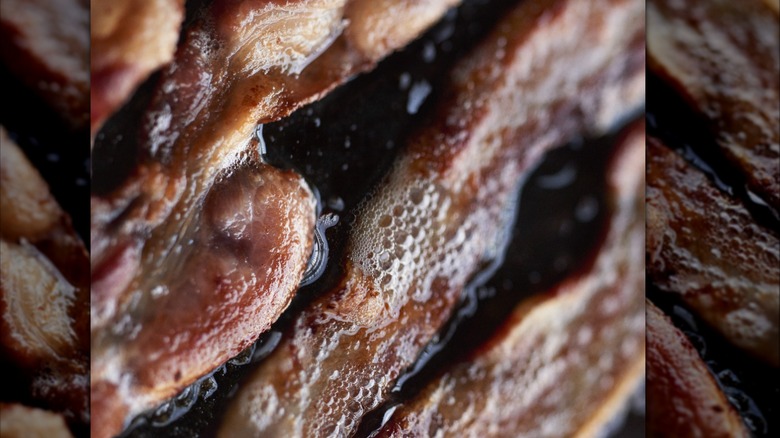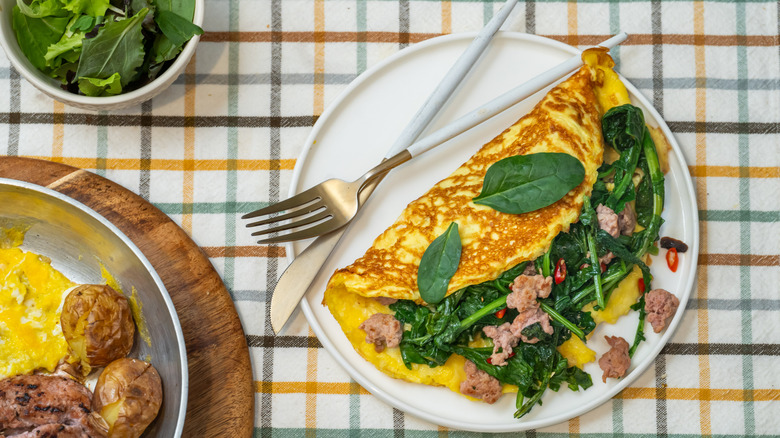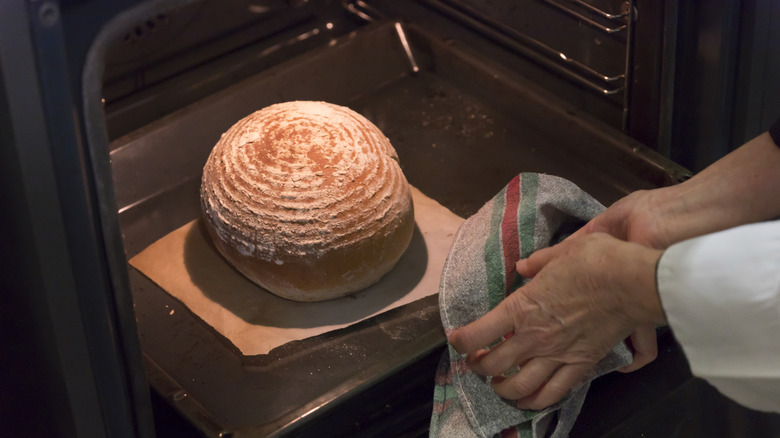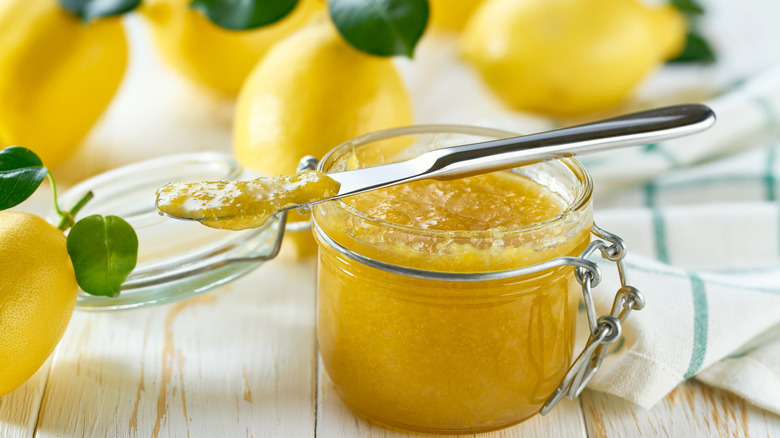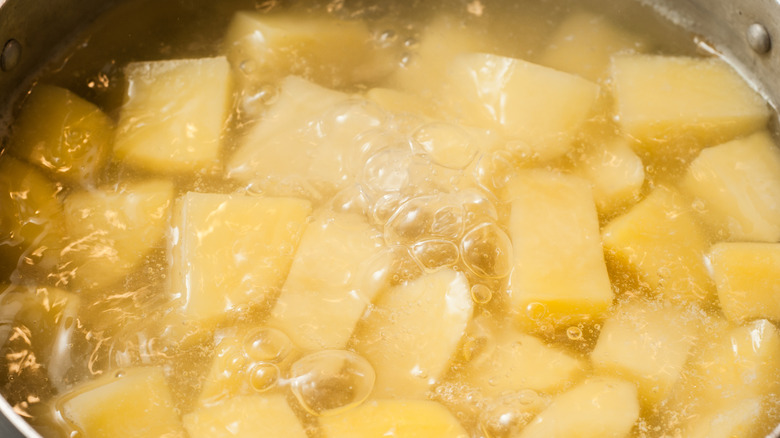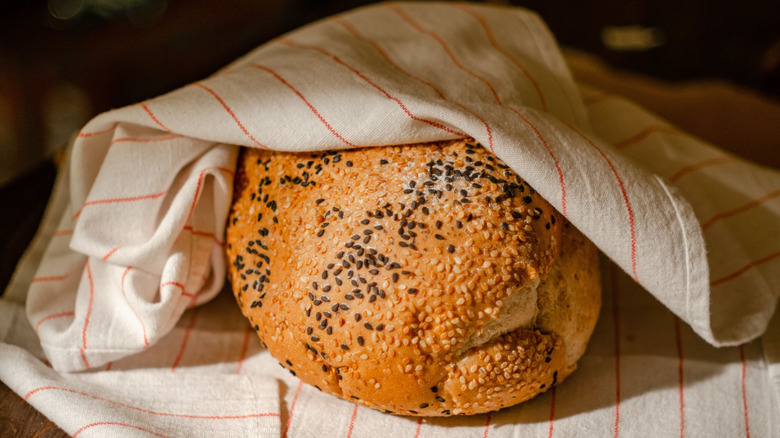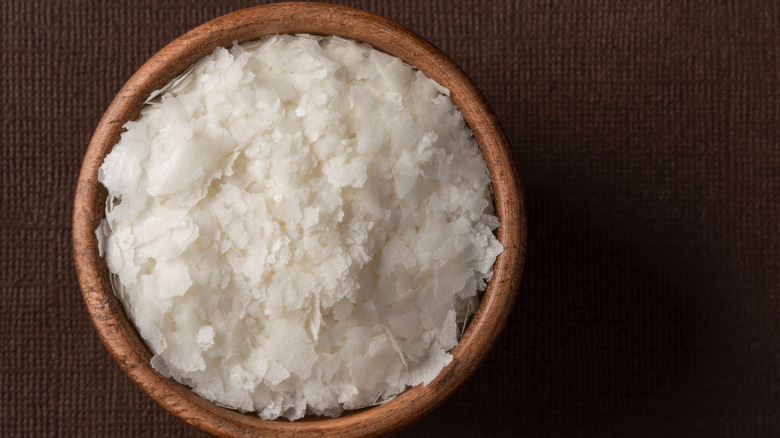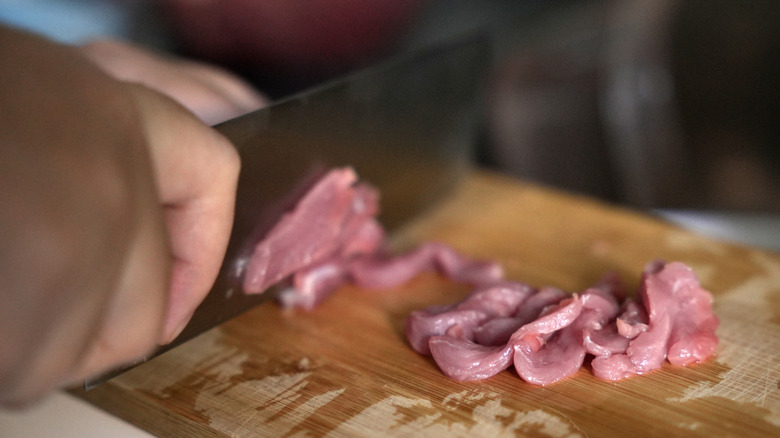Old-School Cooking Tricks People Rarely Use Anymore
While we may not be able to reinvent the wheel, our cooking techniques have become more refined as technology and our understanding of food science continue to improve. Sometimes, solid cooking advice from past generations gets lost in this shuffle, though.
It's always fun to learn about new food hacks on social media, but you might be surprised to learn that some of these trends are recycled from the past. For example, Dalgona coffee took the internet by storm in 2020. But variations of whipped coffee have been trendy in different parts of the world for decades, if not longer, since instant coffee became publicly available in 1903.
Knowing this, it's worth peeling back the layers of cooking innovations throughout history and reacquainting ourselves with how our parents, grandparents, and even older generations worked in the kitchen. Keep reading to learn some old-fashioned cooking tricks that could make your dishes tastier and easier to prepare.
Add some salt to your frying pan to prevent splattering
Nothing tastes better than a homemade meal that's savory, rich, and crunchy. Pan-frying meats and veggies in some butter or oil can make your dish all the more decadent, but the cleanup afterward can be daunting. Grease splatters are notorious for being hard to scrub, and sometimes these splatters can launch all over the kitchen in unexpected places. Even casual home cooks have their battle stories about getting hit with hot oil as well.
What can people do to make the frying process less hazardous? One old-fashioned trick that's been making the rounds on social media is adding a sprinkle of salt all around your frying pan right before you add your meat or vegetables.
You can't expect this trick to work miracles by stopping every grease splatter in the future, but you should notice a big reduction that's worthwhile. Keep in mind that you should only attempt this vintage cooking trick when you're pan-frying rather than deep frying. Another thing you can do in tandem with the salt hack is pat your meats and veggies before they hit the pan to minimize the amount of water reacting to the hot oil.
Save your bacon grease in a glass jar
Have you ever found a weird jar filled with mystery sludge in the cabinet under your mom or grandmother's kitchen sink? It's likely a collection of grease that's released from fatty meats like bacon when they're cooked.
The folks who are already in the know and heed the old-fashioned advice to pour grease into a container may primarily do so nowadays to avoid clogging their sinks with stubborn grease. They may not even cook with the leftovers and just toss the jar in the garbage once it's full. However, bacon grease used to be a hot commodity.
During World War II, Americans did all kinds of things to be frugal. Many of us have heard of victory gardens, but there was also a big campaign to collect bacon grease and hand it over to the government. Apparently, the glycerin found in this grease could be extracted to create explosives. Thankfully, we don't have this initiative around today, but that doesn't mean your bacon grease is useless.
There are all kinds of delicious ways to use bacon grease, which include seasoning your pans and replacing oil in recipes for cornbread, scones, and more. Anything you cook in bacon grease will taste much richer, so it's worth experimenting. If you're a huge bacon lover, you may even want to make bacon candles with the grease if you appreciate the comforting aroma of breakfast.
Get crafty with what you put in your ice cube tray
Ice cube trays were first invented in the 1920s, but they made a huge splash during the '50s and '60s when many Americans enjoyed having friends over for cocktails. While most people used their ice cube trays as intended, there were still plenty of creative home cooks who found ways to preserve perishable ingredients and make their drinks and meals tastier.
One vintage trick is to freeze cherries with some juice. Imagine how good this would be in a Shirley Temple or even a Cherry Coca-Cola. You could even pour some leftover coffee into an ice cube tray when you want to have an iced coffee or anything else caffeinated.
If you ever find yourself with some extra fresh herbs, don't let them wilt. Chop them up and preserve them in convenient portions with some olive oil or butter. Whenever you make pasta, you can pop a cube into your pan while you're whipping up your sauce. You can do the same thing with wine if you don't see yourself getting through the whole bottle within a week.
Everyone knows that the best old-fashioned pancakes get their gorgeous texture from buttermilk. However, you may not go through a whole carton of buttermilk in one go. Another brilliant use is to pour leftover buttermilk into your ice cube tray so you don't have to keep wasting money when you have a hankering for pancakes.
Save soft tomatoes with cold water and salt
We all have the best intentions when we stock our fridges with fresh vegetables. Considering the fact that many Americans don't go grocery shopping every day, it can be challenging to eat healthy because produce spoils quickly. Some fruits and vegetables can be saved if they're starting to get soft, though.
Instead of throwing away your squishy tomatoes, try giving them a cold soak. A tip that was popular in the 1950s was to fill a bowl with cold water and add a teaspoon of salt, then let the tomatoes soak for an hour. The claim is that they'll be as good as new again. According to "America's Test Kitchen," science backs this up.
Vegetables can soak up an impressive amount of water, which makes them firmer. Cold water not only increases the pressure within the cell walls, but it can also bolster pectin, which is a thickening agent. "America's Test Kitchen" noted that veggies can soak up several ounces of water if you leave them in the bath overnight. Bloating your veggies too much could sabotage your dish once more salt is introduced and the water is released, so it seems that the one-hour dip could be the sweet spot.
Baking powder is the secret to fluffier omelets
Are you on the hunt for the perfect omelet? Everyone knows that an omelet needs eggs, salt, pepper, and tasty mix-ins, but one ingredient that could take your homemade omelets to the next level is baking powder. Retro housewives from the '40s and '50s would swear by this technique, but not many folks are aware of it today.
The reason why you'll want to add baking powder to your omelets from now on is that the eggs will be fluffier and bouncier, thanks to all the gas bubbles that baking powder releases once it's heated in liquid. Christopher Kimball, host of "Christopher Kimball's Milk Street," and past host of "America's Test Kitchen," is known for being thorough when he's testing recipes. He approves this addition, so you can trust that the results are legit.
Vintage recipes call for adding 1 teaspoon of baking powder to 4 eggs, but Kimball recommends 1 teaspoon for every half dozen. You can try your own ratios and see what you like best, but don't have a heavy hand. The last thing you'd want to do is ruin your entire breakfast with a bitter taste, especially if egg prices remain high.
Use a string to cleanly cut doughs and cakes
Flipping through old newspapers can reveal all kinds of culinary treasures. One baking tip that was published in "The Decatur Daily Review" in 1960 is to use a piece of string to make clean cuts to baked cakes and pastry doughs. The goal is to avoid a messy battle with your knife and get sloppy results that you wouldn't want to serve to guests.
If you're working with a baked cake, you can wrap the string around it and tug both ends in the opposite direction to level the cake or create even layers. You may even have some luck cutting nice slices once it's frosted, but that's a bit more challenging. To do that, hold both ends of the string above the cake and press down like you would with a knife. You'll have to reposition the string two or three more times to create symmetrical slices.
For dough, you can slip the string underneath so it's completely wrapped and do the same tugging motion in opposite directions. The newspaper clipping swears that all the filling will stay safely inside, which means that you're well on your way toward making the yummiest cinnamon rolls.
Some modern bakers have tried to revive this hack by swapping out string for floss. While you'll still be able to get clean cuts, you need to be careful. If your floss has a minty coating, this flavor could get transferred to the baked goods.
Keep your oven steamy when you make your own bread
Did you jump on the trend of baking bread at home during the pandemic? If you haven't hung up your mitts yet, a vintage newspaper baking tip might be able to help your loaves bake more evenly. In 1953, "The Brockway Record" urged home cooks to keep their ovens steamy while their loaves were baking. According to the clipping, the simplest way you can add steam is to fill a sheet pan with boiling water and set it on the top rack during baking.
King Arthur Baking Company also backs this tip, though it has offered a couple of other ways to create a steamy environment for your bread. King Arthur's top method is to preheat a Dutch oven for 30 minutes, add the loaf, bake with a lid for 20 minutes, then remove the lid to develop a golden crust. If you follow this method, you have to be extremely careful while you're placing the loaf inside the hot Dutch oven and when you remove the lid.
Since baking bread combines art and science, you may want to try a handful of techniques to make your oven steamy and see which loaf turns out the best. Once you learn all the ways to upgrade your homemade bread, you'll be an unstoppable force in the kitchen.
Create lemon and orange peel paste for an easy flavor boost
Before we had the luxury of refrigerating and freezing our food to preserve it, people had to get creative with using every ingredient to the fullest extent. Back in the 1800s, cooks used to make lemon and orange peel preserves that could add a lovely citrusy tang to their meals for months on end. To create it, they'd combine peels, a squeeze of juice, and some powdered sugar to form a shelf-stable paste.
Humans' penchant for citrus hasn't died down over the centuries, so some people still go out of their way to prepare these pastes. Chef Yotam Ottolenghi's modern spin involves boiling lemon slices and blitzing them in a food processor with some salt instead of powdered sugar. Most people enjoy the convenience of buying a bag of lemons or oranges and keeping them in the fridge for several weeks, but you may love the new notes that a citrus preserve could add to both savory and sweet dishes.
Tenderize your meat with baking soda
There's nothing more tragic than spending money on a nice cut of meat, taking the time to marinate it, then realizing that it's too tough to enjoy once you've taken your first bite. One of the oldest cooking tips that's been a staple in Chinese cuisine for centuries is a technique called velveting. It involves marinating meats in a batter composed of baking soda, egg whites, cornstarch, and salt for at least an hour to soften the fibers in the meat before cooking.
Arm & Hammer has also shared that dry and wet brining with baking soda can lead to spectacular results. If you've ever struggled with saltwater brines, baking soda isn't as finicky when it comes to breaking down the meat too much. This means that swapping salt for baking soda could save you from needing to watch the clock like a hawk once you start the marinating process. As it turns out, you only need a teaspoon of baking soda for every 12 ounces of meat to work some magic.
Boil potatoes in cold, salted water
We've been scolded enough to know that we should never dump pasta into a pot of water that isn't already boiling ferociously. It's understandable why this habit could carry over to other types of carbs, like potatoes. While you can still enjoy tasty mashed potatoes by dumping the chopped potatoes into boiling water, this isn't the best method.
Potatoes fare best when you start them in cold, salted water. Letting the potatoes gently heat to a boil ensures that they cook evenly all the way through. Having a perfect texture is especially important if you don't plan on mashing them. Imagine how upsetting it would be to dig into a potato salad and encounter cubed potatoes that are soft on the outside and tough on the inside.
Don't forget to season the cold water with plenty of salt. As your potatoes cook, they'll soak up lots of flavor and depth.
Add moisture to your cakes or old bread by wrapping them in a damp cloth and heating them
Lots of Americans have adopted the practice of storing their bread in the freezer to make it last longer. If you accidentally leave your bread on the counter for a day or two, you might think that your only options are to throw it out or make French toast or bread pudding. In actuality, you can breathe new life into stale bread with a simple vintage trick.
Grab some paper towels and wet them under the faucet. Wring them out a little until they're damp but not soaked. Next, wrap your bread with the damp paper towels until everything is covered. For optimal texture, microwave the bread for 10 seconds to impart moisture, then finish it off in a toaster oven on the lowest toast setting. It sounds impossible, but you can restore the bread's gorgeous, crispy exterior and pillowy interior.
Dry, unfrosted cakes can get a similar treatment as well. Wrap them with damp paper towels and let them sit in the oven at a low temperature until the paper towels seem dry.
Turn meat into a seasoning
Have food costs been hitting your budget hard? If so, you might be trying different strategies to cut your grocery bills. Buying in bulk and switching to generic labels are well-known tricks, but people have handled food and money shortages throughout history in all kinds of clever ways.
Something that could help you stretch your meat further is learning how to use it as a seasoning rather than the main attraction on your plate. Think beyond adding a bit of chopped bacon to your loaded baked potatoes.
One classic trick is adding nutritious filler ingredients that can bulk up your meaty dishes, such as beans, potatoes, oats, and even grated vegetables. You can even pack tons of flavor into your pasta dishes by incorporating a bit of pancetta, since a little goes a long way. Even if you're not worried about your budget, this mindset can still enhance your dishes by deepening the savory flavors.
Use potato flakes to thicken soups and sauces
Soup recipes are always comforting during colder months, but sometimes they can be a real pain to make. Cooking your soup for too long could lead to a texture that's too thick for your liking, and then you might dump too much stock into trying to fix it. Adding various sprinklings of spices can also be stressful since you have to keep scrutinizing the minute changes until you finally get the perfect taste test.
If you ever find yourself with a soup that's too thin and you don't want to wait to cook it down, home cooks from previous generations and even Jacques Pépin all agree that potato flakes should be your favorite secret weapon. Pouring some of these dried flakes into your soup will not only create a more luxurious texture instantly, but they also won't harm the delicate balance of flavors you worked hard to achieve. Instead of whipping up a cornstarch flurry, be adventurous by inviting potato flakes to your next soup party.
Partially freeze your meat if you need to cut thin slices
If you're serious about making restaurant-style Philly cheesesteaks or deli subs at home, maybe you've already invested in a meat slicer. However, lots of people are trying to cut down on kitchen gadgets and appliances to prevent clutter. It's also normal to feel hesitant about using heavy-duty equipment like that since there are plenty of terrifying finger casualties each year.
As it turns out, we can look into the past to find a simple way to cut razor-thin slices of meat without any drama. All you need is a freezer. There's a delicate balance of chilling your meat enough to stay firm under the pressure of a knife without being frozen and requiring a chainsaw to cut through. Each type of meat will fare best with different freezing times based on the thickness and other factors, but the general rule of thumb is to check on your meat after 30 minutes. If you wait any longer, you run the risk of dealing with an impenetrable ice block.


